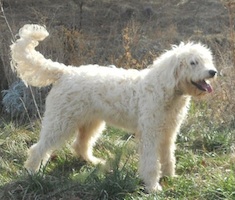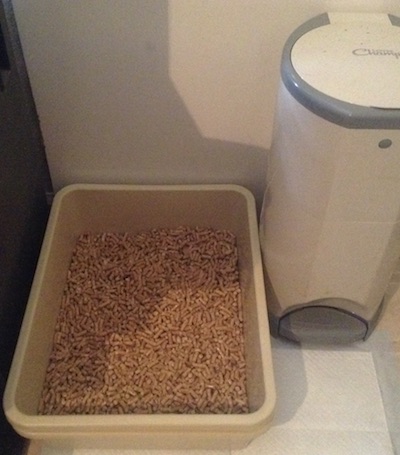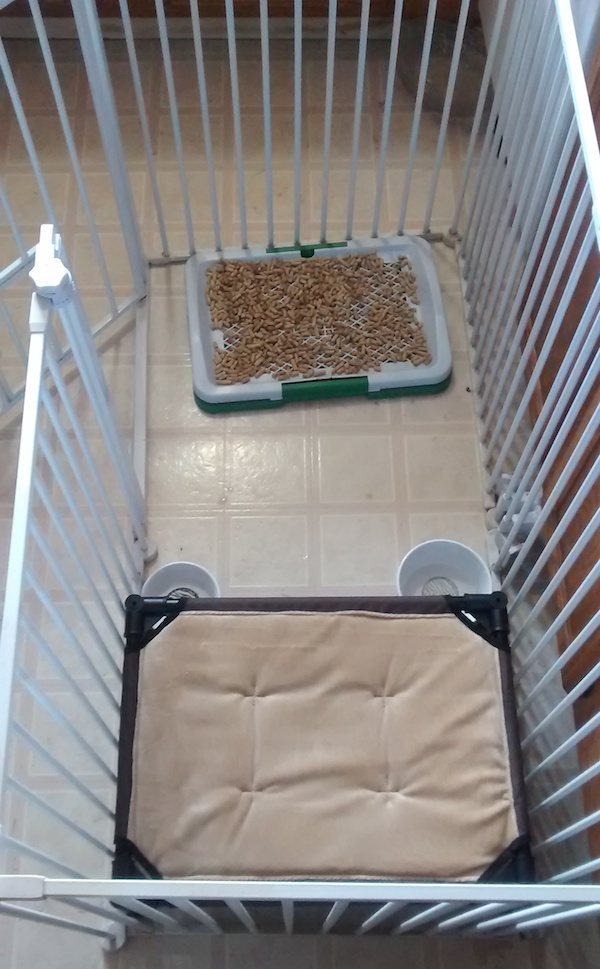
| DOODLES |
| OUR DOGS |
| PUPPIES |
| VIDEO |
| PUPPY CARE |
PartiDoodle.com
| Caring for your new puppy |
|
Feeding: Get a ceramic water bowl Pet Bowls Potty Training: The Carlson Convertible Pet Yard  You might also want to get a pet crate, because its good for overnight if you want to put it next to your bed, and safer for traveling. The puppy also can't climb out of it.
You might also want to get a pet crate, because its good for overnight if you want to put it next to your bed, and safer for traveling. The puppy also can't climb out of it. For one of our Bridget's or Sophi's puppies, get a MidWest 30" Dog Crate Health Care: Worming; Your puppy has been wormed recently and should be free of worms, but the stress of a new home may cause a new outbreak. You can routinely worm him 2 weeks after bringing him home or if you see any worms you can give him an over the counter wormer, or have a fecal test done at his next scheduled vaccination. Grooming: It is best to trim your puppy’s nails every month. Teach your puppy to lay in your lap and rest while you brush his fur with a pin brush. He won’t need much brushing now, but it’s a good habit to get into once a week. It will get you ready for your 1 year old’s first spring when you’ll have to keep up with small mats getting in the coat and get them out before they get bigger. Your puppy is changing to it's adult coat at that time and it matts easily and may shed some. After that it is much easier to care for. Don’t leave those mats for the groomer to get out, or your dog will not enjoy going to the groomer. Test your brushing job with a fine tooth comb. The groomer is there to trim your dog’s rear, feet, in front of the eyes and the matts you can’t get out, or you can learn to do it yourself. Ask your groomer for a round face and short round ears for your doodle to look most like a teddy bear. Or you can go with a terrier look with eyebrows and a mustache. If you bathe your dog be sure to trim his rear and get the matts out first or they well “set” and be impossible to brush out. I recommend you get your dog clipped with a lamb clip in the spring, short on the legs for the summer if you have stickers, and a lamb clip again in the fall. Coat: The doodles with the furriest faces are usually the dogs that don’t shed. The dogs that have sparser fur on their face but still a bearded look are usually low shedding. Feeding a raw meat diet helps the fur to be much healthier so it stays on the dog in the off seasons. They will still shed in the spring, but it should happen quickly instead of being spread throughout the year. Giving a warm bath and brushing will help the process be over with quicker. Ears: Sometimes when puppies go through teething their ears can go different directions with the fluctuation of calcium. If the fold goes the wrong way on the side, you can put some fabric glue on the inside of the crease and press it into place. It will naturally come off after a while and the ear should stay in place. Heartworms; Your puppy has been mostly inside and only outside mid day so can't have heartworms. You will want to start him on a monthly heartworm preventative when you bring him in to the Vet for his next vaccination. Fleas; Your puppy shouldn’t have fleas when he leaves here. If you do find any fleas on your puppy, Advantage is a mild medication that works well. If you see itching and no fleas, Revolution works well for parasites you can’t see and also prevents heartworms. Holding; When you or someone else is holding your puppy make sure he is supported well so he can’t jump or fall. It’s also best to not wear shoes when he’s running around the house in case he gets stepped on so it won’t hurt so much. Teeth; Baby teeth may need to be pulled if they don’t fall out by themselves. This can be done when your puppy is being neutered after 6 months of age. Raw chicken wings are a good supplement and will clean his teeth when he eats the bones. Don’t feed any cooked bones. If you don't fred bones, you should brush your puppy's teeth. Only the ouasides of the teeth need to be brushed, and the sides of the mouth are where they need it the most. Chewing: Your puppy will need to chew on things. Give him appropriate toys to chew on. If he's chewing on something undesired, you can spray it with a great product called Bitter Apple spray, and offer your puppy his chew toy instead. In his playpen get a toy with a loop so it can be attached to the fence with a carabiner above his bed so it doesn't get dirty. Barking; If your puppy is barking too much, say "No" and stop playing with him for a while. If he still barks too much, an aluminum can with pennies in it can be shaken to startle him to stop. Digging; If your puppy is digging holes outside, fill the hole up with his own feces. That will stop it quickly! Socialization; It is important for your puppy to meet new people and experience new situations and sounds, especially within his first 3 months of life. Don’t let your puppy get too scared, but to be a little frightened of something new and find out it doesn't hurt him does great things for his temperament later. You shouldn't bring your puppy to places where other puppies have been until after 16 weeks of age. That includes parks, especially dog parks, pet stores, apartment complexes, etc. An exception would be an organized indoor socialization class where the area is disinfected and kept clean. It is a great place and time for your puppy to learn to get along well with other puppies and people. A UC Davis study found that there wasn't a greater risk of Parvo infection from these kinds of classes, and there is a great benefit from them. Training; Your puppy should be signed up for a group obedience class as soon as he is old enough. Your puppy can have a regular collar with tags on it for identification, and a martingale collar for walking outside on a leash. It tightens when they pull so they can't slip it over their head. You can adjust it so it won't get too tight. Harnesses teach them to pull. Treats can be used if he's not learning without them. They're good when introducing him to new situations that are scary to him (swimming, nail trimming, stairs, doggie doors, etc.). Treats can be regular dry dog food if you want to feed him that anyway. You can make treats by cooking the boneless, skinless chicken meat, and chopping into small pieces. You can feed his whole meal as treats. Make him earn his food. You don't need to feed him in a bowl at all. Let him earn his meal during training. You can also put food in a Kong toy with peanut butter when you want him to be occupied for a while. Sleep; Puppies need to sleep about half of their day time hours. If you have children make sure they're letting your puppy get enough sleep. When you want your puppy to sleep, he would appreciate a bottle with warm water in it, or a warming disk, to snuggle up with, since he is used to sleeping with his siblings. Get a soft toy with a loop to attach it to his cot so it will always be there when he sleeps on it. At night time if you want your puppy to sleep with you, you can put dog stairs next to your bed, with his litter tray at the bottom of the stairs. Or he can sleep in a crate next to your bed, or in his playpen. Spaying and neutering; Can be done any time before your puppy is 8 months old.
|
